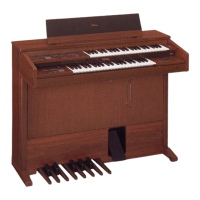Do you have a question about the Yamaha Electone FS-300 and is the answer not in the manual?
Controls for selecting and blending voice sections for Upper and Lower keyboards.
Details on the 'Combination' voice section for Upper and Lower keyboards.
Explains the tone levers and presets within the Combination section of the Preset Panel.
How to store and recall custom voice settings using memory buttons.
Adds a 'click' effect to Combination voices for stylistic simulation.
Adjusts the tone color (brightness or mellowness) of Combination voices.
Factory-set vibrato for voices, indicated by an illuminated button.
Feature that makes keyboards responsive to playing touch for expression.
Explains velocity and pressure sensitivity for Touch Tone expression.
Enables touch-sensitive expression for specific voice groups.
Effect simulating mallet or picking techniques on specific voices.
Describes preset and touch-activated vibrato for custom voices.
Adds touch responsiveness to custom voices for enhanced expression.
Pedal bass sounds using the Combination voice section.
Pedal bass sounds using custom voice selections.
Adjusts harmonic emphasis for pedal custom voices, affecting tone.
Explores the fourteen available solo voices for the FS-500.
Links Solo Keyboard voices to the Upper Keyboard with altered priority.
Slightly adjusts the pitch of the Solo Keyboard relative to others.
Changes the octave register of Solo Keyboard voices.
Controls for vibrato effect on Solo Keyboard voices.
Enables touch-sensitive expression for Solo Keyboard voices.
Adjusts harmonic content for Solo Keyboard sounds.
Adds a portamento (glide) effect to Solo Keyboard voices.
Controls the gradual fade-out of sound after key release.
Uses a knee lever to toggle Sustain effect on Upper/Lower keyboards.
Creates a 'symphony-like' sound by layering slightly varied instruments.
Applies a cyclic variation in amplitude (volume) to sounds.
Explains pitch variation effects (depth, delay, speed) for voices.
Procedure to save custom vibrato settings into memory.
Method to switch between factory and user-defined vibrato settings.
Lowers pitch by approximately half a step, also affects vibrato.
Adjusts the overall tuning (A=440Hz reference) of the instrument.
Adjusts relative volume balance between Upper and Lower keyboards.
Details on selecting and using various rhythm styles and their variations.
Methods for initiating rhythm playback, including synchronized starts.
Adjusting the speed (beats per minute) of the Auto Rhythm Unit.
Visual cue for the first beat of each measure and tempo indication.
Balances the volume levels of individual percussion instruments.
Shows tempo, measure/beat, and programmer status.
Adds short fill-in patterns or 'breaks' to the rhythm.
Using break variations to create rhythmic intros.
Automatically inserts rhythm variations at set intervals.
Step-by-step guide to recording rhythm patterns and breaks into memory.
Techniques for sequencing multiple programs and manually adding breaks.
Controls for selecting and blending voice sections for Upper and Lower keyboards.
Details on the 'Combination' voice section for Upper and Lower keyboards.
Explains the tone levers and presets within the Combination section of the Preset Panel.
How to store and recall custom voice settings using memory buttons.
Adds a 'click' effect to Combination voices for stylistic simulation.
Adjusts the tone color (brightness or mellowness) of Combination voices.
Factory-set vibrato for voices, indicated by an illuminated button.
Feature that makes keyboards responsive to playing touch for expression.
Explains velocity and pressure sensitivity for Touch Tone expression.
Enables touch-sensitive expression for specific voice groups.
Effect simulating mallet or picking techniques on specific voices.
Describes preset and touch-activated vibrato for custom voices.
Adds touch responsiveness to custom voices for enhanced expression.
Pedal bass sounds using the Combination voice section.
Pedal bass sounds using custom voice selections.
Adjusts harmonic emphasis for pedal custom voices, affecting tone.
Explores the fourteen available solo voices for the FS-500.
Links Solo Keyboard voices to the Upper Keyboard with altered priority.
Slightly adjusts the pitch of the Solo Keyboard relative to others.
Changes the octave register of Solo Keyboard voices.
Controls for vibrato effect on Solo Keyboard voices.
Enables touch-sensitive expression for Solo Keyboard voices.
Adjusts harmonic content for Solo Keyboard sounds.
Adds a portamento (glide) effect to Solo Keyboard voices.
Controls the gradual fade-out of sound after key release.
Uses a knee lever to toggle Sustain effect on Upper/Lower keyboards.
Creates a 'symphony-like' sound by layering slightly varied instruments.
Applies a cyclic variation in amplitude (volume) to sounds.
Explains pitch variation effects (depth, delay, speed) for voices.
Procedure to save custom vibrato settings into memory.
Method to switch between factory and user-defined vibrato settings.
Lowers pitch by approximately half a step, also affects vibrato.
Adjusts the overall tuning (A=440Hz reference) of the instrument.
Adjusts relative volume balance between Upper and Lower keyboards.
Details on selecting and using various rhythm styles and their variations.
Methods for initiating rhythm playback, including synchronized starts.
Adjusting the speed (beats per minute) of the Auto Rhythm Unit.
Visual cue for the first beat of each measure and tempo indication.
Balances the volume levels of individual percussion instruments.
Shows tempo, measure/beat, and programmer status.
Adds short fill-in patterns or 'breaks' to the rhythm.
Using break variations to create rhythmic intros.
Automatically inserts rhythm variations at set intervals.
Step-by-step guide to recording rhythm patterns and breaks into memory.
Techniques for sequencing multiple programs and manually adding breaks.
| Type | Electronic Organ |
|---|---|
| Amplification | Built-in amplifier |
| Keyboard | 49 keys |
| Rhythms | Various |
| Sound Generation | AWM (Advanced Wave Memory) |
| Effects | Reverb, Chorus, Sustain |
| Speakers | 2 speakers |
| Power Supply | AC 100V |











